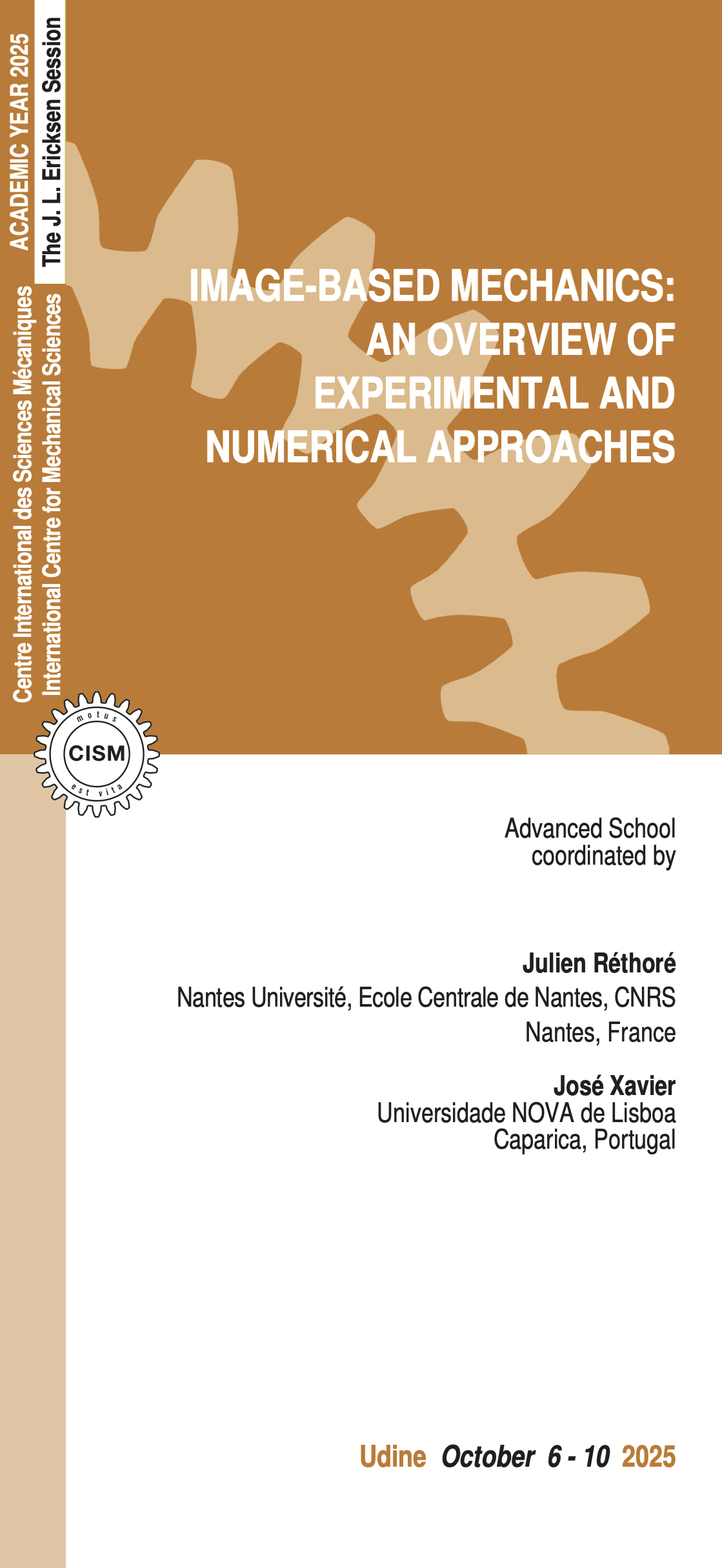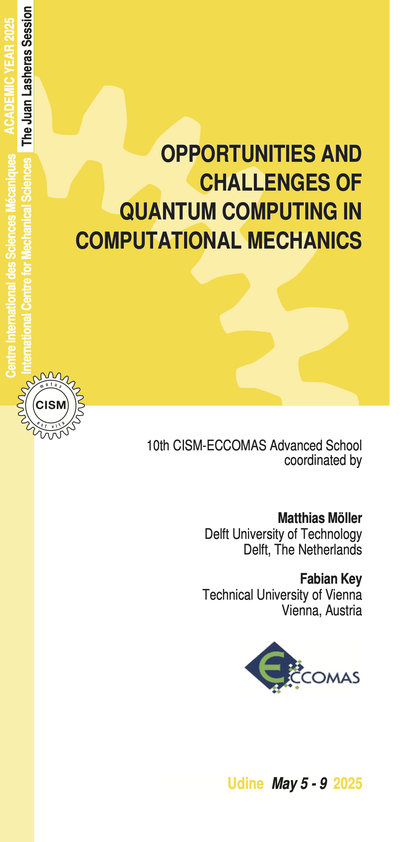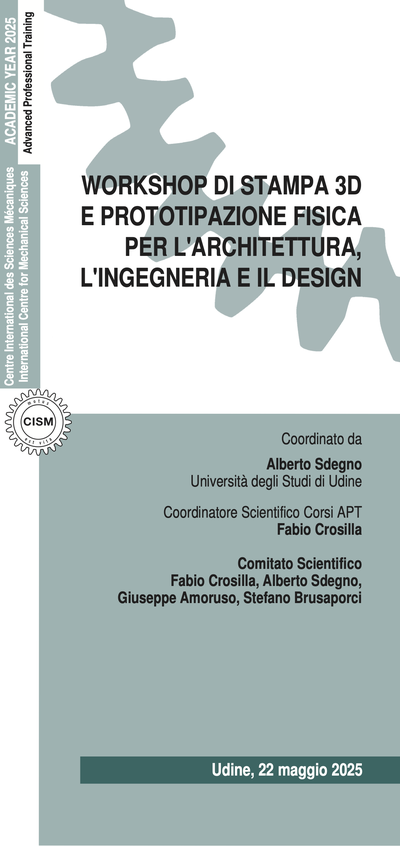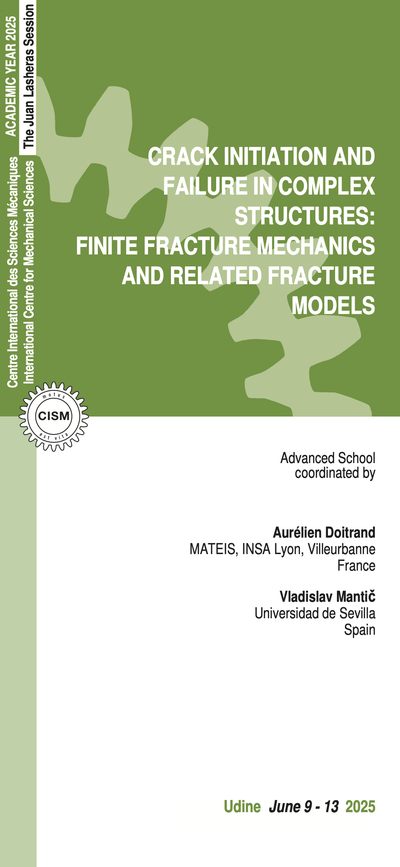The proposed course is aimed at drawing an overview of recent developments in the field of image-based mechanics to give the participants clues for understanding how images are acquired, used or analysed and how they can be used for understanding and validation purposes. Having a global vision of the whole pipeline from the lab to the computing center is essential for practitioners and researchers to make their work more effective. The course is divided into several blocks to answer the following questions: how are images acquired? What can we do with images? How is image analysis formulated/implemented? How robust are the results? To help the participants in their future use of images, this comprehensive overview of fullfield measurements deployment and quantitative image analysis is coupled with an in-depth exploration of best practices in formulation and implementation. The immense potential of these techniques is showcased through discussions on related inverse methods for material characterisation, multimodal setups, and in-situ/in-operando implementations but also on the evaluation of their performance.
Among the possible uses of images in mechanical analysis, full-field displacement measurements and microstructure analysis are covered. Concerning full kinematic field measurements, an overview of different versions and their associated practical implementation in the lab is presented together with an introduction of the numerical implementation of digital image correlation (DIC), localized spectrum analysis (LSA) and optical flow (OF) methods. Applications and specific features of 2D, stereo and volume imaging will be discussed. Quantitative image analysis is discussed for microstructure characterization and crack detection using 3D images. Various image processing techniques, from classical mathematical morphology to machine learning-aided image segmentation, are introduced and discussed. Approaches for model-based quantitative image analysis will also be showcased. Requirements on image resolution and methods for correcting sampling biases will be addressed.
From the results obtained using the previously mentioned techniques, it is now common to identify the mechanical behaviour of the studied materials at the chosen observation scale.
The course thoroughly explores advanced identification methods, offering participants a deep understanding of techniques such as Finite Element Model Updating (FEMU) and Virtual Fields Method (VFM). Through practical demonstrations and theoretical discussions, participants will gain proficiency in implementing these advanced methods to enhance material characterisation and simulation accuracy. Recently proposed non-parametric (without postulating a constitutive relation) identification techniques based on the data-driven paradigm will also be introduced theoretically and practically. These approaches require a computational model numerically twinning the sample. A short overview of the computational issues regarding geometrical description and computational efficiency is also proposed. Last, the question of robustness is covered. To this end, uncertainty quantification will be considered as an ongoing issue.
Michael A. Sutton, Jean-José Orteu, Hubert Schreier. "Digital Image Correlation for Shape and Deformation Measurements: A Background to Digital Image Correlation Techniques", Springer, 2009.
International DIC Society, Jones, E.M.C. and Iadicola, M.A. (Eds.) (2018). A Good Practices Guide for Digital Image Correlation.
Grédiac, M., & Hild, F. (Eds.). (2012). Full-field measurements and identification in solid mechanics. John Wiley & Sons.
Vander Linden, K., Fehervary, H., Vastmans, J., Famaey, N. (2023). The influence of out-of-plane motion on the deformation measurement of planar biaxial tests on biological soft tissue. Mechanics Research Communications, 129, Art.No. 104099.
A. Majano-Majano, A.J. Lara-Bocanegra, F. Pereira, J. Xavier, J. Morais, M.F.S.F. de Moura. Direct and inverse cohesive law identification of hardwood bonded joints with 1C-PUR adhesive using DCB test. Composite Structures, 316:117013, 2023.
Grediac, M., Sur, F., & Blaysat, B. (2016). The Grid Method for In-plane Displacement and Strain Measurement: A Review and Analysis. Strain, 52(3), 205-243.
Nogatz, T., Redenbach, C., & Schladitz, K. (2022). 3D optical flow for large CT data of materials microstructures. Strain, 58(3), e12412.
Pierré, J. E., Passieux, J. C., & Périé, J. N. (2017). Finite element stereo digital image correlation: framework and mechanical regularization. Experimental Mechanics, 57, 443-456.
6 lectures on:
LSA (theory, implementation & examples), Assessment of the metrological performances of full-field measurement methods (DIC/ LSA, from images to kinematic fields), Patterning Techniques.
6 lectures on:
Basics of mechanical characterization & parameter fitting: uniaxial, biaxial and unconfined compression testing, Image-based baseline geometry & deformation analysis, Micro-CT based multiscale modelling (including calibration with mechanical test data).
6 lectures on:
Theory and implementation of (FE-)DIC/DVC: functional, regularisation, a priori error estimate, Hands-on on FE-DIC/DVC, Data Assimilation and optimisation of identification tests setups, Overview of image-based models.
6 lectures on:
Statistical aspects of image analysis: scales, resolution, sampling and discretization effects, Basics of image processing, Geometric microstructure characteristics, Quantitative image analysis: application examples and interpretation, Motion estimation by optical flow, Synthetic data for method validation.
6 lectures on:
Finite Element Model Updating (FEMU), Data-driven identification (DDI), Image based FE.
6 lectures on:
2D and 3D digital image correlation: guidance and practical concepts, The virtual fields method: extracting material parameters from heterogeneous fields, Material testing design using synthetic images, Notebook-based hands-on workshops.convallis aenean et.
ADMISSION AND ACCOMMODATION
The course is offered in a hybrid format, allowing participants the flexibility to attend either in person or remotely via the Microsoft Teams platform.
Admission to on-site attendance is granted on a first-come, first-served basis to comply with the capacity of the lecture room.
Application forms should be submitted online through the website: http://www.cism.it. A confirmation message will be sent to participants whose applications are accepted.
Registration fees:
- Early Bird On-Site Participation: € 650.00 + VAT* - Deadline: August 6, 2025
- Late On-Site Participation: € 800.00 + VAT* - Deadline: September 23, 2025
- Live Streaming Online Participation: € 250.00 + VAT* - Deadline: September 23, 2025
On-site participation includes a complimentary bag, five fixed menu buffet lunches, hot beverages, downloadable lecture notes.
Online participation includes downloadable lecture notes.
Upon request, and subject to availability, a limited number of on-site participants can be accommodated at the CISM Guest House for € 35 per person per night. To request accommodation, please contact foresteria@cism.it.
CANCELLATION POLICY
Applicants may cancel their registration and receive a full refund by notifying the CISM Secretariat in writing (via email) no later than:
- August 6, 2025, for early bird on-site participation;
- September 6, 2025, for late on-site participation;
- September 23, 2025, for online participation.
No refunds after the deadlines. Cancellation requests received before these deadlines and incorrect payments will be subject to a € 50.00 handling fee.
GRANTS
A limited number of participants from universities and research centers who do not receive support from their institutions can request a waiver of the registration fee and/or free lodging.
Requests should be sent to the CISM Secretariat by July 30, 2025, along with the applicant's curriculum vitae and a letter of recommendation from the head of the department or a supervisor confirming that the institute cannot provide funding. Preference will be given to applicants from countries that sponsor CISM.





